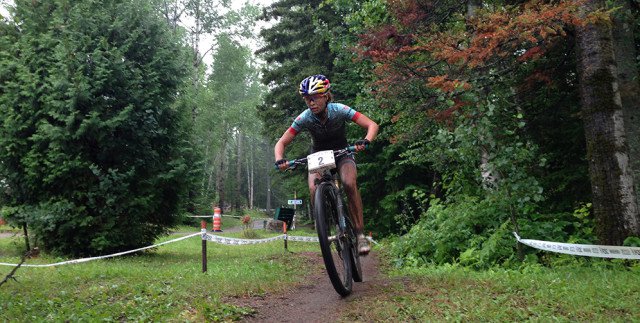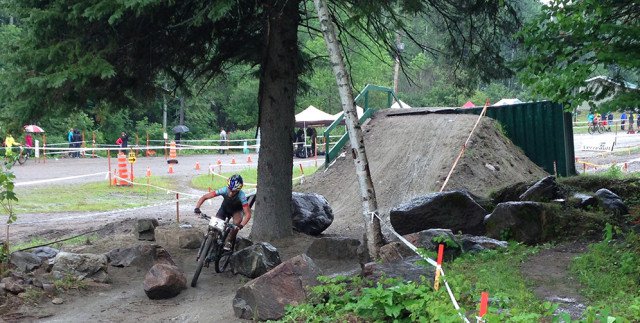Become a Better Mountain Biker with these Tips from Emily Batty
Ride faster in the mud, around corners, and over obstacles with pointers from the Canadian pro.
Ride faster in the mud, around corners, and over obstacles with pointers from the Canadian pro. – By Molly Hurford

Emily Batty (Trek Factory Racing) has been racing for 17 years, during which time she has become one of Canada’s best pro mountain bikers. This summer, she won the Pan American Games cross country mountain bike race and finished second at the Canadian Mountain Bike National Championships to current World Champion Catharine Pendrel. Although Batty does have high hopes for finishing off her 2015 season well at the World Championships in Andorra, her sights are set firmly on the 2016 Olympic Games in Rio.
After wiping the mud off her face following a rainy National Championship race, she shared her best tips for how to become a better technical rider. Whether you’re new to mountain biking, or you’ve been riding the trails for years, Batty says that you can constantly improve your technical riding skills.
Don’t Let the Bike Smell Your Fear
Don’t be shy around your bike—ride it with confidence.
“When you meet a dog for the first time, it can sense your intimidation if you’re nervous,” says Batty. “Riding in mud is similar in the sense that if you’re overthinking it or wondering if you’re going to slide out or crash, you might find out that you’re analysing too much and end up on the ground.”
Speed is Your Friend
Although it may seem counterintuitive, more speed makes riding many technical sections easier. Try going faster next time your gut reaction is to slow down.
“When you’re going over a rock pile, speed keeps you from getting rocked around,” Batty says. “A bit more speed smooths out everything, even though going faster can be intimidating.”
Carrying speed is just as important in muddy situations, but don’t grab your brakes—especially the front brake—at the first sign of not feeling in control, or you might end up suddenly sliding out.
Learn From the Experts
Batty isn’t referring to other pro mountain bikers, though that can help, too. Instead, she enjoys learning from the pros in one of her favourite non-cycling sports: motocross.
“Watch motocross because all the riders do is manoeuvre around corners and mud,” she says. “It’s insane how much the bike can float underneath them, and they don’t go down. You want to let the bike move beneath you: don’t fight the mud, just go with it!”
“When the bike slides around, the tyres are naturally trying to find traction. It doesn’t necessarily mean that you’re going to fall.”

Obstacles are for Everyone
Batty is often asked how to ride over logs. “You don’t need to be a muscle man to learn the concept,” she says. “Once you figure out the motion and timing and can carry enough momentum, it doesn’t matter how strong you are.”
She suggests taking advantage of your front suspension by pushing down on your fork right before an obstacle. Then as the fork reopens, pull up on the bars as you pedal over the obstacle.
Learn to Late Brake
Most people want to be prepared for what’s coming, but sometimes riders slow down too much in advance.
“Practice pedalling toward turns longer than you naturally tend to do so,” says Batty, “so if you’re making a 90-degree left turn, don’t stop pedalling until maybe three meters before the turn. You’ll carry more speed through the turn.”
Pedal Through Obstacles
Pedalling over obstacles is a good skill to have. It makes you faster, but you will have to practice your timing and finesse to learn how to make it work.
“Just try smashing into obstacles so you see how rough they are, then start pulling up a bit, and it will becomes natural to carry more speed over them,” says Batty.
One Last Piece of Advice
Perhaps the hardest skill to practice is a mental one: Forget about not making it over a log or crashing on a descent.
“If you dab or make a mistake, don’t dwell on it,” says Batty. There’s always tomorrow for another ride and more opportunities to practice.
READ MORE ON: Skills training programmes workouts

